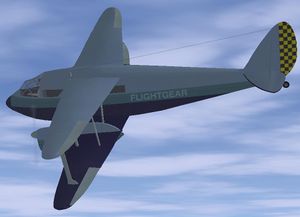de Havilland DH.89 Dragon Rapide
 | |
|---|---|
 | |
| Type | Airliner, Historical aircraft |
| Configuration | Biplane aircraft |
| Propulsion | Piston aircraft, Twin-engine aircraft |
| Manufacturer | de Havilland |
| Author(s) |
|
| FDM | YASim |
| --aircraft= | dh89 |
| Status | Alpha |
| FDM |
|
| Systems |
|
| Cockpit |
|
| Model |
|
| Development | |
| Hangar |
|
| Website |
|
| Repository |
|
| Download |
|
| License | GPLv2+ |
|
| |
The de Havilland DH.89 Dragon Rapide was a British short-haul passenger airliner of the 1930s. Designed by the de Havilland company in late 1933 as a faster and more comfortable successor to the DH.84 Dragon, it was in effect a twin-engined, scaled-down version of the four-engined DH.86 Express. It become perhaps the most successful British-built commercial passenger aircraft of the 1930s.
The prototype first flew on 17 April 1934 and 205 were built for owners all around the world before the outbreak of World War II. Originally designated the "Dragon Six" it was first marketed as "Dragon Rapide" although was later just called a "Rapide". With the fitting of improved trailing edge flaps from 1936, they were redesignated DH.89As.
Source: Wikipedia
Characteristics and Performance
General characteristics
- Crew: 1
- Capacity: 8 passengers
- Length: 34 ft 6 in (10.5 m)
- Wingspan: 48 ft 0 in (14.6 m)
- Height: 10 ft 3 in (3.1 m)
- Wing area: 340 ft² (32 m²)
- Empty weight: 3,230 lb (1,460 kg)
- Loaded weight: 5,500 lb (2,490 kg)
- Powerplant: 2× de Havilland Gipsy Six inline engine, 200 hp (149 kW) each
Source: Wikipedia
Performance
- Maximum speed: 157 mph (136 kn, 253 km/h) at 1,000 ft (305 m)
- Range: 573 mi (498 nmi, 920 km)
- Service ceiling: 16,700 ft (5,090 m)
- Rate of climb: 867 ft/min (4.3 m/s)
- Wing loading: 16 lb/ft² (79 kg/m²)
- Power/mass: 0.036 hp/lb (60 W/kg)
Source: Wikipedia
Operation
Starting the Engines
Do not use the controls on the 2D panel to set the magnetos, throttle, mixture, etc. The 2D panel controls are only connected to the left engine and have no effect on the right engine.
Instead use keyboard commands to start the engines:
- ~ select all engines.
- } } } set magneto to "all".
- s start the engines--you may need to hold this a second or two.
- Check that both engines are running and engaged with the throttle by revving up the throttle briefly while watching the dual RPM meters (low on the control panel).
Taking off
- Set throttle to 100%.
- Release parking brake (B).
- Best results on takeoff have been obtained with no flaps set.
During initial roll-out, steer via very light touches of the right and left brakes (, and .)--be aware that too strong application of the brakes will nose the plane over very easily.
Around 40 knots/60 KPH the rudder starts to become responsive but the best procedure for takeoff seems to be to keep moderate stick back to keep the rear wheel on the ground to about 60 knots, and continue steering with the right and left brakes to this moment.
At about 60 knots, ease the stick forward gently and the DH-89 will lift off.
Immediately level off, just a few feet off the ground, and build speed to 80 knots, when it is safe to start climbing at up to 500 fps.
80 knots is a safe speed for climbing--if the speed drops below about 60 knots you will stall badly and most likely crash.
The cockpit has a fairly low configuration when compared with most other FlightGear cockpits so it is easy to climb at a steeper rate than you intend, leading to drop in speed, stall, and crash--just watch the instruments carefully.
Stall speed is just below 60 knots/100 KPH. The stall speed appears to be the same regardless of flap setting.
The flaps appear to have little affect on lift but function more as speed brakes.
Landing
As with takeoff, the best procedure seems to be to land with no flaps.
Similar to the instructions for landing a light Cessna aircraft, use the ailerons to control the speed and the throttle to control the rate of descent.
Safe descent speed (no flaps) is 80 knots--any slower than that is dangerously close to stall speed.
Once on the ground, gently pull back to bring the tail wheel in contact with the ground. Then continue to hold the stick back to counteract the tendency to nose over.
Steer (gently!) with the right and left brakes (, and . keys). Note the tendency of the DH-89 to nose over with any too-hard application of the brakes.
Note: the above instructions are based on experimentation with the DH-89 in FlightGear and are not necessarily best practices for flying a real DH-89!
External links
| ||||||||